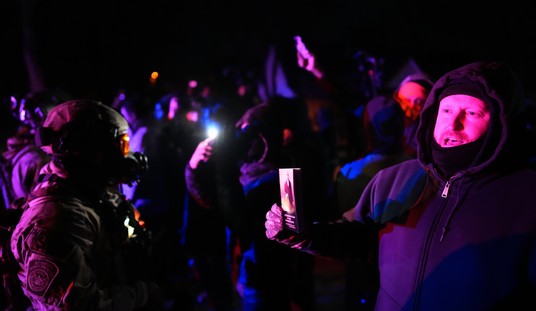Seventy-five years ago today, one of the most remarkable events in the Second World War took place — and quite arguably, one of the greatest feats in military history.
On this date in 1944, 76 Allied officers and men, mostly British, escaped from Stalag Luft III near Sagan, Germany in what came to be known as “The Great Escape.”
If you’ve seen the 1963 movie — or much better yet, read the book by former Sagan POW Paul Brickhill which was a true factual account — you know the story.
Initially, the camp housed airmen from all Allied nations except the Soviet Union, but eventually, the Americans were moved to camps of their own. This was because they got along very well with the British and proceeded to help them rob the German guard staff nearly blind for escape items.
The work began after three other POWs broke out of Stalag Luft III in one of the most brilliant escapes known to history.
Known as the “Wooden Horse” escape, it worked like this: each day, prisoners would bring a vaulting box to the center of the compound for exercise, placing it in the same spot every day. Inside the horse was a prisoner, who would work on a tunnel whose trap was located underneath the spot where the horse was placed.
Eventually, three prisoners broke out through the tunnel and all three made it to neutral Sweden.
The Germans were thus on their guard and wasted no time separating the British and Americans. Before they left, though, the Americans helped the British start construction of three tunnels, known as Tom, Dick and Harry.
Tom was eventually found by the Germans, but as Dick and Harry grew longer, it became more and more difficult to disperse the sand displaced from the digging of tunnels. For a time, this responsibility belonged to Colonel Jerry Sage, an American nicknamed “Silent Death” who was an early member of “Wild” Bill Donovan’s Office of Strategic Services, the forerunner to today’s CIA.
But, back to sand. Dispersing it was where prisoners known as “penguins” came in. They would place woolen underpants tied at the feet under their greatcoats and inside their pants, releasing sand into the compound which they would then tread into the soil while they walked. The issue was that the sand underneath the camp was both loose and of a different color than the topsoil, presenting challenges to the prisoners.
After Tom was found, the idea was hit upon to store sand from Harry’s construction inside Dick, the third tunnel. This, and an ingenious plan to store sand underneath the sloping floor of the camp theater, resulted in Harry’s completion in early 1944 (pictures at link).
March 24, 1944 was a moonless night. As the first prisoners emerged from the exit to the tunnel, they found it was too short — ending about thirty feet short of the tree line across the road from the camp. The original plan called for 200 prisoners to escape but the delays caused by having to exit the tunnel in the open dramatically curtailed the number of men who could get out.
After 76 men had escaped, the Germans finally figured out what was going on and secured the exit, ending the escape.
Once the tunnel was discovered, the Germans discovered how intricate the escape operation had been:
“4,000 bed boards had gone missing, as well as the complete disappearance of 90 double bunk beds, 635 mattresses, 192 bed covers, 161 pillow cases, 52 20-man tables, 10 single tables, 34 chairs, 76 benches, 1,212 bed bolsters, 1,370 beading battens, 1219 knives, 478 spoons, 582 forks, 69 lamps, 246 water cans, 30 shovels, 1,000 feet of electric wire, 600 feet of rope, and 3,424 towels. 1,700 blankets had been used, along with more than 1,400 Klim cans. The electric cable had been stolen after being left unattended by German workers; as they had not reported the theft, they were executed by the Gestapo. From then on each bed was supplied with only nine bed boards which were counted regularly by the guards.”
This left the Germans with a dilemma — finding the escapees and deciding on punishment. Eventually, all but three were captured.
Adolf Hitler advocated shooting all the recaptured men but fear of reprisals against German POWs led Hitler to order that “more than half” of the recaptured men be executed. The decision on who lived and who died was left to General Arthur Nebe, former commander of the Einsatzgruppe B extermination unit in Russia. Nebe himself was only months away from death — he took part in the July 20, 1944 bomb plot against Hitler and was himself later executed by the Nazis.
The number Nebe decided upon was fifty. And so, men began to die. The escape’s “Big X”, or leader, Squadron Leader Roger Bushell, was executed along with most of the escape’s ringleaders.
Two were spared, in all likelihood, because of their names. Bomber pilot Dick Churchill and Squadron Leader Bob Nelson, who the Germans thought was related to Admiral Horatio Nelson, were returned to custody.
Four were sent to Sachsenhausen Concentration Camp, from which they almost immediately escaped. Most of the surviving officers were sent to Oflag IV-C, known as Colditz, for the duration of the war.
After the war, the British hunted down many of the Germans who had done the killing, but as was often the case with trials of “lesser” war criminals, were unable to secure lengthy prison sentences for many of the guilty.
The three men who made it all the way to safety from the Great Escape were:
- Per Bergsland, Norwegian pilot of No. 332 Squadron RAF, escapee #44
- Jens Müller, Norwegian pilot of No. 331 Squadron RAF, escapee #43
- Bram van der Stok, Dutch pilot of No. 41 Squadron RAF, escapee #18
Some of the survivors lived very long lives. Churchill was the last of the original escapees to pass away, dying just 37 days ago at the age of 99.
The commandant of Stalag IV-C, Colonel Friedrich Wilhelm von Lindeiner-Wildau, also had an interesting story. A fervent patriot but strident anti-Nazi, von Lindeiner accepted his posting as a way to serve his country while staying as far away from the Nazi regime as possible. Relieved of command after the escape, von Lindeiner faked mental illness to avoid court-martial. He was captured by the Soviets while serving in an infantry regiment defending Sagan, and lived until 1963.
And for those of you who are curious and fans of Hogan’s Heroes — there really was a Stalag 13 in World War II. Housing American prisoners, Stalag XIII-D was built on the former grounds of the Nuremberg Nazi Party rallies of the 1930s.
Happy Sunday and enjoy today’s open thread!















Join the conversation as a VIP Member